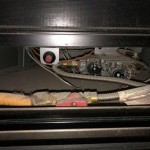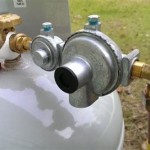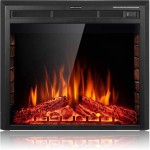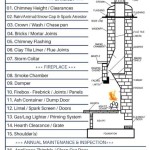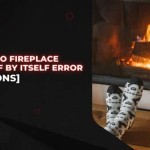Electric Fireplace Insert Blower Not Working: Troubleshooting and Solutions
Electric fireplace inserts offer a convenient and aesthetically pleasing alternative to traditional fireplaces. They provide supplemental heating, often with realistic flame effects, without the complexities of wood-burning or gas-fueled systems. A crucial component in many electric fireplace inserts is the blower, responsible for circulating the heated air into the room, maximizing efficiency and comfort. When the blower malfunctions, the fireplace's heating performance is significantly diminished, leading to frustration and a need for troubleshooting.
This article will explore common reasons why an electric fireplace insert blower might stop working, along with practical steps to diagnose and potentially resolve the issue. While some problems can be addressed by the homeowner, others might necessitate professional assistance. Understanding the potential causes and appropriate solutions is crucial for maintaining the functionality and longevity of the electric fireplace insert.
Power Supply and Electrical Connections
The most fundamental aspect to investigate when an electric fireplace insert blower fails is the power supply. Begin by verifying that the fireplace is properly plugged into a functioning electrical outlet. Test the outlet with another appliance to confirm it is delivering power. If the outlet is faulty, try a different outlet or have the original outlet repaired by a qualified electrician.
Many electric fireplaces have a dedicated on/off switch, often located on the side or back panel. Ensure this switch is in the 'on' position. Verify that any remote control features for the fireplace are also correctly configured to enable the heating function. Some models require specific settings or a separate 'blower' activation button on the remote. Consult the user manual for detailed instructions on the remote control operation.
Internal electrical connections within the fireplace itself are another potential point of failure. Even with a proper external power supply, loose or damaged wiring inside the unit can prevent the blower from receiving power. Disconnecting the fireplace from the power source and carefully inspecting the wiring harness is crucial. Look for obvious signs of damage, such as frayed wires, burnt connectors, or loose terminals. If any such issues are detected, it is recommended to seek assistance from a qualified electrician or appliance repair technician. Attempting to repair electrical wiring without proper knowledge and experience can be dangerous and could further damage the unit.
Overheating and Thermal Protection
Electric fireplace inserts are equipped with various safety mechanisms to prevent overheating and potential fire hazards. One common safety feature is a thermal overload protector, also known as a thermal cutoff or thermostat. This device is designed to automatically shut off the heating element, including the blower motor, if the fireplace's internal temperature exceeds a safe threshold. The thermal overload protector is usually a small, resettable switch located near the heating element or the blower motor.
Overheating can occur due to several reasons, including restricted airflow around the fireplace, a clogged air filter (if the unit has one), or a malfunctioning heating element. If the thermal overload protector has tripped, it will typically need to be manually reset. To locate and reset the protector, first disconnect the fireplace from the power source. Consult the user manual for the specific location of the reset button or switch. Typically, it will be a small red or black button. Press the reset button firmly and reassemble the fireplace. Reconnect the power and test the blower. If the blower still does not function, the thermal overload protector may be faulty and require replacement.
Ensuring adequate airflow around the electric fireplace insert is crucial for preventing overheating. Avoid placing objects directly in front of the fireplace that could obstruct the flow of air. Regularly clean any air filters according to the manufacturer's instructions. If the fireplace is installed in an enclosed space, such as a custom-built mantel, verify that there is sufficient ventilation to dissipate the heat generated by the unit.
Blower Motor Malfunction and Obstructions
The blower motor itself is a mechanical component that is susceptible to wear and tear over time. A common cause of blower motor failure is the accumulation of dust, debris, and pet hair within the motor housing. This buildup can impede the motor's rotation, causing it to slow down, overheat, or eventually seize completely.
To inspect the blower motor, disconnect the fireplace from the power source and carefully disassemble the unit according to the manufacturer's instructions. Locate the blower motor and examine it for visible signs of dust and debris. Use a vacuum cleaner with a brush attachment to thoroughly clean the motor housing and the blower fan blades. Compressed air can also be used to dislodge stubborn debris. Ensure that the fan blades can rotate freely without any obstruction.
In some cases, the blower motor may require lubrication. Consult the user manual to determine if the motor is designed to be lubricated and the recommended type of lubricant to use. Applying a small amount of lubricant to the motor bearings can help reduce friction and improve its performance. However, excessive lubrication can attract more dust and debris, so it's important to apply it sparingly.
If cleaning and lubrication do not resolve the issue, the blower motor may be damaged or worn out and require replacement. Replacement blower motors can typically be purchased from the fireplace manufacturer or from appliance parts suppliers. Ensure that the replacement motor is compatible with the specific model of electric fireplace insert. Installation may require some mechanical skills, but it is often a straightforward process.
Finally, ensure that there are no physical obstructions preventing the blower from operating. Small objects, such as screws, wires, or insulation fragments, can sometimes become lodged within the blower assembly, preventing the fan blades from rotating. Carefully inspect the area around the blower for any such obstructions and remove them.

Troubleshooting Dimplex Optimyst Fire Part 2 Mist Not Working Replacing The Fan
Osburn 2000 Insert Blower Hearth Com Forums Home

Cambridge 22 8 In W Black Fan Forced Electric Fireplace The Fireplaces Department At Com

Clihome 48 In W Brown Tv Stand With Fan Forced Electric Fireplace The Fireplaces Department At Com

Bossin 18 Inch Electric Fireplace Insert With Touch Screen Remote Cont

Cambridge 6 Corded 19 Wood Electric Fireplace Mahogany Heater Heat Blower 1350w

Huntington Fireplaces Sparkling 49 75 In Black Fan Forced Electric Fireplace Ef Hp50 Rona

Clihome Flame 50 In Wall Mounted Automatic Constant Temperature Electric Fireplace Insert Ef50r The Home Depot

Buck Stove Model 34 Vent Free Gas Fireplace Contemporary Hvacdirect Com

Comfort Zone Up To 1500 Watt Fan Cabinet Indoor Electric Space Heater With Thermostat In The Heaters Department At Com
Related Posts

